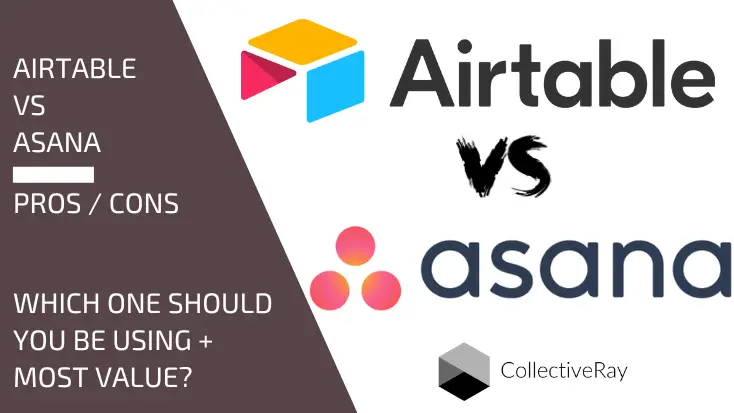
Do you think you need project management software for your small business? The article pits Airtable vs Asana in a head-to-head comparison so you can figure out which one is best for you.
{autotoc}
Summary
|
ASANA
|
AIRTABLE
| |
|---|---|---|
|
What We Like |
|
|
|
What We Don't Like |
|
|
|
Key Features |
|
|
|
Pricing |
Basic: Free Premium: $10.99/user/month with annual contract Business: $24.99/user per month with annual contract Enterprise: Negotiated with client |
Free: Unlimited databases, 1,200 records per database, 2GB storage per base, mobile app Plus: $10/user/month, 5,000 records per database, 5GB storage per base Pro: $20/user/month, 50,000 records per database, 20GB storage per base, advanced calendars Enterprise: Negotiated with client |
|
Support |
Only online forum support is available with the free plan. Phone and concierge support are included in paid plans. |
Mostly forums, tutorials, and videos on the internet. There is no telephone support. |
|
Ease of Use |
One of the easiest PM tools for beginners |
Great visuals help organize tasks Powerful tool with a learning curve |
Choosing software can feel like a game of chance: everything looks great on the surface, but who knows what the real results will be after a few months of use?
It can be difficult to tell the difference between project management tools if you're new to project management.
Airtable and Asana are two popular project management software options that have a lot of features in common.
Below, we'll go over their respective advantages and disadvantages so you can pick the best one for your small business.
“COVID-19 accelerated the role of agile transformations by a decade.”
– Sean Regan, Atlassian Head of Product Marketing, Software Teams
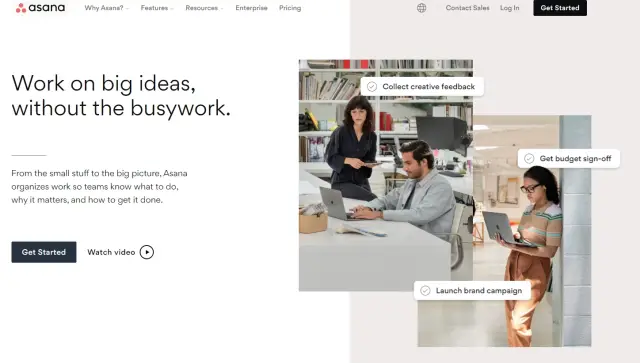
Airtable vs Asana - An overview
For project management and collaboration, Airtable employs a hybrid database and spreadsheet system. Its visual interface and flexibility will appeal to creative project teams.
Airtable might be the right software for you if you want more collaboration within your team and more transparency for your stakeholders.
Asana is a collaboration tool rather than a project management tool. It organises everything from granular tasks to overall business objectives, ensuring that your teams are always aware of their roles and responsibilities.
The worker-centric features of Asana could be your best bet if you want to incentivize each team member to use the software for their own benefit and the projects at hand.
Who is Airtable designed for?
Small businesses can use Airtable's billing, budgeting, and resource management features to collaborate with external clients and project teams within larger organisations. Expedia, Netflix, and Shopify are among the companies that use Airtable.
What is the purpose of Asana?
Asana is best suited to smaller teams working on internal projects due to its lack of invoicing, billing, and extensive reporting features. Airbnb, Pinterest, and Uber are among the companies that use Asana.
Airtable vs Asana - Features
Many of the features of Airtable and Asana are similar, so which one you choose depends on the specific functionality you require and are willing to pay for.
What Airtable offers
Six components make up Airtable project management:
- Workspaces are a collection of foundations.
- Bases are collections of tables that contain information that can be used to create projects.
- Tables: Spreadsheets containing project data.
- Individual entries in a table are referred to as fields.
- Table rows are referred to as records.
- Views are the results of data searches that have been filtered.
Although Airtable is based on the spreadsheet concept, you won't be forced to look at your grandfather's Excel files. Its ability to view bases, projects, and tasks in boards using a gallery, calendar, and kanban project management system is one of its strengths.
You can also use filters to create boards, such as category, client, due date, project team, and start date.
The gallery view on an Airtable board displays cards sorted by user-selected criteria.
Other features of Airtable include:
- Scheduler for tasks
- Calendars for the entire team
- Dashboards for groups
- Keeping track of time
- Management of resources
- sharing of files
There are no built-in reports or budgeting tabs in Airtable. Instead, the records and categories you create in Airtable can be used to create reports. Don't know how to use Airtable's spreadsheets to create a budget? Airtable has a number of templates that can be used to create the necessary framework.
Custom reports make use of Airtable's grouped records feature, which groups records based on one or more fields you specify, such as completed tasks, deals, qualified leads, and more.
What Asana offers
Asana project management allows you to structure your projects in a variety of ways, including task lists, Gantt charts, and kanban boards. When creating, scheduling, and prioritising tasks, you have the freedom to track your project and teams according to your needs.
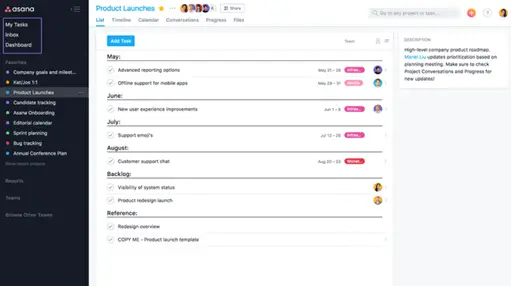
To see your personal Asana to-do list, go to the My Tasks option at the top of the left-hand navigation menu.
Asana also has the following features:
- Scheduler for tasks and subtasks
- Approvals
- Calendar shared by the entire team
- Sharing of files
- Keeping track of time
- Milestones
- Fields that can be customized
The reports option in the left-hand interface menu shows which tasks have been completed and which are still in progress, but that's where the reporting features end. Other reporting tools, such as Everhour, Google Sheets, and Hourstack, are all integrated with Asana.
Are you interested in other project management tools - check out Asana vs Monday and our list of Asana alternatives.
Results
Here, Airtable comes out on top. Each provides similar project views and organisational schemas, such as Airtable and Asana Gantt charts, but Airtable's custom reporting capabilities expand its functionality and use.
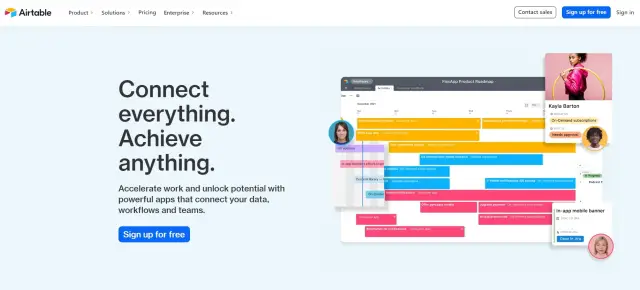
Airtable vs Asana - Support
To keep your project management software running, you'll need customer support. To keep things from grinding to a halt when you encounter an issue, be aware of all your options — online, one-on-one, free, paid.
What Airtable offers
Standard customer service and support options are available through Airtable:
- All plans have email support.
- Knowledge base
- Discussion board for the community
- Tutorials on the internet
- Webinars and videos for training
If you have the enterprise plan, you can get phone support or one-on-one training from Airtable. When it comes to other plans, the knowledge base is your best bet for finding answers.
Alternative text: Airtable's knowledge base is divided into eight sections: Airtable basics, views, blocks, fields, managing Airtable, developers, Airtable on your device, policies and compliance, and so on.
Airtable offers a variety of project templates, but its Airtable Universe goes above and beyond with a gallery of user bases to browse and copy for your own use. A student planner, a legislative bill tracker, a product launch calendar, and many more are among the hundreds of real-world projects.
What Asana offers
Asana offers the following standard customer service options:
- Email assistance is available.
- Knowledge base
- Discussion board for the community
- Tutorials on the internet
- Webinars and videos for training
Asana does not provide phone support, so its knowledge base, like Airtable's, is your best first resource for information.
You can expand your options by selecting one of the three options. The "I want to learn..." section, for example, delves into details about tasks and projects, workspaces and organisations, profile settings, and other subjects.
Results
Here, Airtable comes out on top. Both provide standard customer support options and resources, but neither offers lower-tier users telephone support. Airtable Universe stands out because it has the potential to revolutionize project management.
Airtable vs Asana - Ease of use
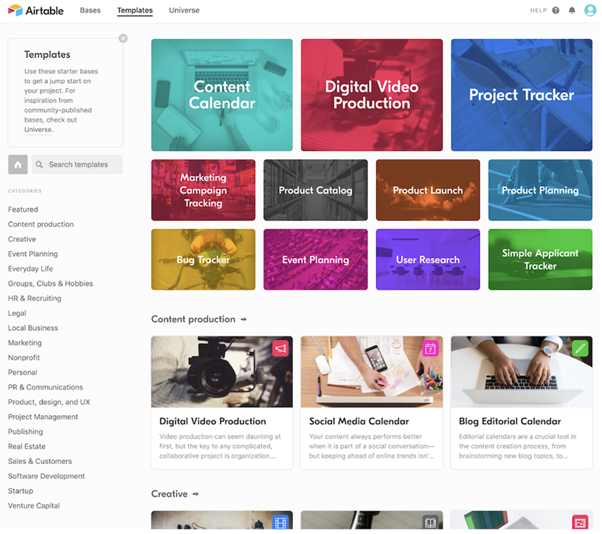
Because you never want a software to get in the way of actual project planning and subsequent work, ease of use is critical.
What Airtable offers
Because it is based on spreadsheets, Airtable may appear intimidating at first, but it goes out of its way to make setting up your first project simple. Do you have a product launch coming up? Do you require a bug tracker? Do you want to do some user research? Airtable has project schedule templates that can help you with all of this and more.
Product launch, product catalogue, and bug tracker projects are among the Airtable project templates, which are organised in categories such as content production and marketing.
Airtable prioritises visuals to contextualise and organise your tasks and processes, despite the fact that it was built on spreadsheets. It has an engaging feel thanks to the images used in kanban boards and shared calendar tasks.
Although learning to use Airtable isn't difficult, it does have some quirks with task creation and filtering that require more effort than anticipated, so you might prefer one of the Airtable alternatives.
What Asana offers
Asana also strives to make new user onboarding as painless as possible. When you first log into Asana, you can choose from a variety of templates for your first project, including:
- Bug-hunting
- Fundraising campaign on the internet
- Calendar of publications
- Agenda for the meeting
- Onboarding new employees
- Roadmap for the product
Most project management software focuses on the project manager, but Asana's task manager and workload management feature will help keep team members from becoming burnt out. You can see the team and individual workloads on the workload tab, and you can assign an effort level to each task.
Capacity refers to the maximum amount of work a person can handle in a week and is adjustable on an individual basis. An independent contractor, for example, may be able to work only 20 hours per week, whereas a full-time team member may be able to work 40 hours per week.
The workload graph of someone who has more work than their assigned capacity turns red.
Results
Because Airtable's quirks take time to figure out, Asana comes out on top. Asana also has tracking capabilities to assist in balancing everyone's workload.
Airtable vs Asana - Pricing
Where the rubber meets the road is in pricing: You'd like to give everyone on your team access to every feature, but that's unlikely unless you have a lot of money. A cost-effective plan, on the other hand, is the result of negotiations between your wants and needs.
What Airtable offers
- Free: Includes unlimited bases, each with two gigabytes of file space and 1,200 records, as well as grid, calendar, form, kanban, and gallery views, as well as real-time collaboration and commenting via web, desktop, iOS, and Android apps.
- Plus: for $10 per month per user, you get five gigabytes of storage space and 5,000 records per base.
- Pro: $20/month per user — Increases storage space to 20 gigabytes and adds advanced calendar features, custom branded forms, personal and locked views, password and domain restricted shares, and priority customer support.
- Enterprise: Quote-based — Includes unlimited workspaces, an enterprise-wide admin panel, enhanced deletion recovery, individualized onboarding and training, and a dedicated customer success manager, as well as an increase in storage space to 1,000 gigabytes per base.
Airtable is best for creative teams that provide services and products to clients, such as graphic design or marketing agencies. Even for small teams, the cost per user at the pro level, which is the plan that even smaller businesses need to access necessary features, dramatically raises the monthly cost.
What Asana offers
Basic: Create tasks with up to 15 team members using list, board, and calendar views, assign tasks and due dates, use mobile apps and a Chrome extension, and use software integrations.
Premium: $10.99 per user per month — Includes a timeline view, advanced search and reporting, custom fields, unlimited free guests, forms, rules, milestones, admin console, and private teams and projects.
Business: Portfolios, workload tracking, custom rules builder, approvals, proofing, lockable custom fields, and advanced integrations with Salesforce, Adobe Creative Cloud, Tableau, and other software are all included for $24.99 per user per month.
Enterprise: User provisioning and de-provisioning, data export and deletion, custom branding, priority support, cross-regional backups, and a 99.9% uptime service level agreement are all included in the quote-based option (SLA).
Smaller teams with large budgets can also benefit from Asana. Teams of ten users, like Airtable, will pay more than $100 per month for the premium plan, which does not include workload tracking or Adobe Creative Cloud integration.
Results
Pricing is a tie between Airtable and Asana. Each has the same problems: Despite the fact that it offers a free plan, even small businesses will pay well over $100 per month to gain access to essential business features.
Airtable vs Asana - Integration with other software
Because, like most businesses, you probably use a variety of software applications, your project management software should be able to integrate with them seamlessly to avoid time-consuming and/or manual data transfer processes.
Keep an eye on the budget: multiple integrations may necessitate a more expensive subscription plan. A one-time fee or a monthly subscription may be required for third-party apps and plug-ins. Companies that connect multiple pieces of software, such as Zapier, charge their own monthly fees.
What Airtable has to offer
Airtable comes with seven pre-built integrations:
- Box
- Dropbox
- Gmail
- Google Drive
- JotForm
- Slack
- Typeform
Airtable now has 25 pre-configured Zapier integrations that automate connections with software like Basecamp, Instagram, Mailchimp, and Twitter. Alternatively, you can use Automate.io, Zenaton, or another third-party vendor to create your own custom connections.
What Asana offers
Asana integrations include over 150 options in nine categories:
- Communication
- Connectors
- Development
- File sharing
- Forms
- Importers
- Reporting
- Time tracking
If you or your team has the coding ability, use Asana's application programming interface (API) to create your own custom actions.
Results
Because of its numerous native integrations, Asana comes out on top. Airtable uses Zapier as a connector to connect it to other software, but one-to-one communication between your project management software and Airtable is preferable.
Airtable earns a narrow victory
So how do we conclude this Airtable vs Asana showdown?
Airtable and Asana are best for the same types of users: small, creative project teams. The overall feature set of Airtable, which includes advanced reporting, external billing and invoicing, and Airtable Universe, puts it ahead of the competition.
If you prefer more native integrations, want to use its workload reporting feature, or only do in-house projects, Asana may still be a viable option.
Airtable vs Asana FAQs
Is it possible to connect Airtable and Asana?
No code is required to send data between Airtable and Asana using Zapier or Make. This should be done automatically! It adds a task to a project section.
What is the purpose of Airtable?
Airtable is an online platform for creating and sharing relational databases that is simple to use. The user interface is straightforward, colorful, and user-friendly, allowing anyone to create a database in minutes.
Is Airtable a better alternative to Asana?
Airtable is better than Asana at organizing and storing large amounts of data. It has a number of features that allow it to recreate the advantages of a spreadsheet. Asana's features are more akin to those of a database-only application, whereas Airtable offers both spreadsheet and database functionality.
